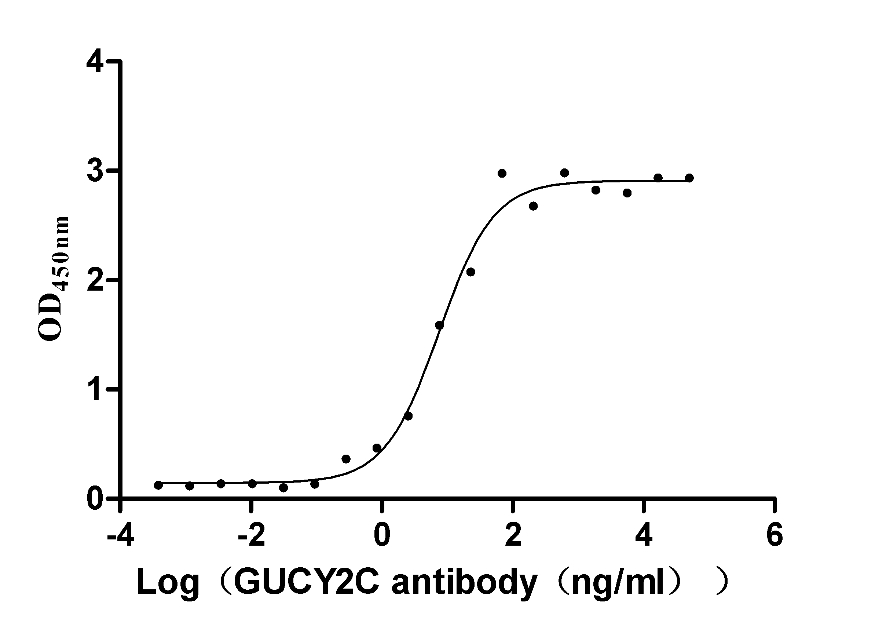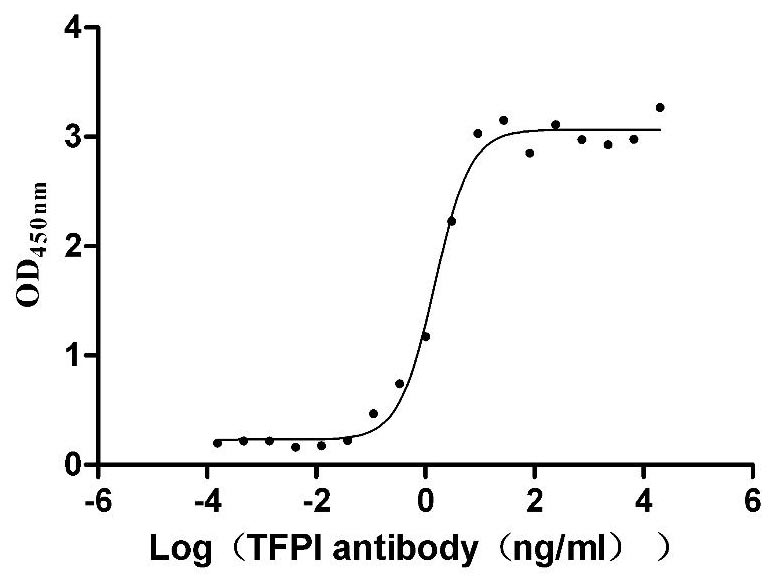Recombinant Human DNA-directed primase/polymerase protein (PRIMPOL)
-
中文名称:人PRIMPOL重组蛋白
-
货号:CSB-YP822255HU
-
规格:
-
来源:Yeast
-
其他:
-
中文名称:人PRIMPOL重组蛋白
-
货号:CSB-EP822255HU
-
规格:
-
来源:E.coli
-
其他:
-
中文名称:人PRIMPOL重组蛋白
-
货号:CSB-EP822255HU-B
-
规格:
-
来源:E.coli
-
共轭:Avi-tag Biotinylated
E. coli biotin ligase (BirA) is highly specific in covalently attaching biotin to the 15 amino acid AviTag peptide. This recombinant protein was biotinylated in vivo by AviTag-BirA technology, which method is BriA catalyzes amide linkage between the biotin and the specific lysine of the AviTag.
-
其他:
-
中文名称:人PRIMPOL重组蛋白
-
货号:CSB-BP822255HU
-
规格:
-
来源:Baculovirus
-
其他:
-
中文名称:人PRIMPOL重组蛋白
-
货号:CSB-MP822255HU
-
规格:
-
来源:Mammalian cell
-
其他:
产品详情
-
纯度:>85% (SDS-PAGE)
-
基因名:PRIMPOL
-
Uniprot No.:
-
别名:CC111_HUMAN; CCDC111; Coiled coil domain containing 111; Coiled-coil domain-containing protein 111; DNA-directed primase/polymerase protein; MYP22; Primase and polymerase (DNA directed); PRIMPOL
-
种属:Homo sapiens (Human)
-
蛋白长度:full length protein
-
表达区域:1-560
-
氨基酸序列MNRKWEAKLK QIEERASHYE RKPLSSVYRP RLSKPEEPPS IWRLFHRQAQ AFNFVKSCKE DVHVFALECK VGDGQRIYLV TTYAEFWFYY KSRKNLLHCY EVIPENAVCK LYFDLEFNKP ANPGADGKKM VALLIEYVCK ALQELYGVNC SAEDVLNLDS STDEKFSQHL IFQLHDVAFK DNIHVGNFLR KILQPALDLL GSEDDDSAPE TTGHGFPHFS EAPARQGFSF NKMFTEKATE ESWTSNSKKL ERLGSAEQSS PDLSFLVVKN NMGEKHLFVD LGVYTRNRNF RLYKSSKIGK RVALEVTEDN KFFPIQSKDV SDEYQYFLSS LVSNVRFSDT LRILTCEPSQ NKQKGVGYFN SIGTSVETIE GFQCSPYPEV DHFVLSLVNK DGIKGGIRRW NYFFPEELLV YDICKYRWCE NIGRAHKSNN IMILVDLKNE VWYQKCHDPV CKAENFKSDC FPLPAEVCLL FLFKEEEEFT TDEADETRSN ETQNPHKPSP SRLSTGASAD AVWDNGIDDA YFLEATEDAE LAEAAENSLL SYNSEVDEIP DELIIEVLQE
-
蛋白标签:Tag type will be determined during the manufacturing process.
The tag type will be determined during production process. If you have specified tag type, please tell us and we will develop the specified tag preferentially. -
产品提供形式:Lyophilized powder
Note: We will preferentially ship the format that we have in stock, however, if you have any special requirement for the format, please remark your requirement when placing the order, we will prepare according to your demand. -
复溶:We recommend that this vial be briefly centrifuged prior to opening to bring the contents to the bottom. Please reconstitute protein in deionized sterile water to a concentration of 0.1-1.0 mg/mL.We recommend to add 5-50% of glycerol (final concentration) and aliquot for long-term storage at -20℃/-80℃. Our default final concentration of glycerol is 50%. Customers could use it as reference.
-
储存条件:Store at -20°C/-80°C upon receipt, aliquoting is necessary for mutiple use. Avoid repeated freeze-thaw cycles.
-
保质期:The shelf life is related to many factors, storage state, buffer ingredients, storage temperature and the stability of the protein itself.
Generally, the shelf life of liquid form is 6 months at -20°C/-80°C. The shelf life of lyophilized form is 12 months at -20°C/-80°C. -
货期:Delivery time may differ from different purchasing way or location, please kindly consult your local distributors for specific delivery time.Note: All of our proteins are default shipped with normal blue ice packs, if you request to ship with dry ice, please communicate with us in advance and extra fees will be charged.
-
注意事项:Repeated freezing and thawing is not recommended. Store working aliquots at 4°C for up to one week.
-
Datasheet :Please contact us to get it.
相关产品
靶点详情
-
功能:DNA primase and DNA polymerase required to tolerate replication-stalling lesions by bypassing them. Required to facilitate mitochondrial and nuclear replication fork progression by initiating de novo DNA synthesis using dNTPs and acting as an error-prone DNA polymerase able to bypass certain DNA lesions. Shows a high capacity to tolerate DNA damage lesions such as 8oxoG and abasic sites in DNA. Provides different translesion synthesis alternatives when DNA replication is stalled: able to synthesize DNA primers downstream of lesions, such as ultraviolet (UV) lesions, R-loops and G-quadruplexes, to allow DNA replication to continue. Can also realign primers ahead of 'unreadable lesions' such as abasic sites and 6-4 photoproduct (6-4 pyrimidine-pyrimidinone), thereby skipping the lesion. Also able to incorporate nucleotides opposite DNA lesions such as 8oxoG, like a regular translesion synthesis DNA polymerase. Also required for reinitiating stalled forks after UV damage during nuclear DNA replication. Required for mitochondrial DNA (mtDNA) synthesis and replication, by reinitiating synthesis after UV damage or in the presence of chain-terminating nucleotides. Prevents APOBEC family-mediated DNA mutagenesis by repriming downstream of abasic site to prohibit error-prone translesion synthesis. Has non-overlapping function with POLH. In addition to its role in DNA damage response, also required to maintain efficient nuclear and mitochondrial DNA replication in unperturbed cells.; Involved in adaptive response to cisplatin, a chemotherapeutic that causes reversal of replication forks, in cancer cells: reinitiates DNA synthesis past DNA lesions in BRCA1-deficient cancer cells treated with cisplatin via its de novo priming activity. Repriming rescues fork degradation while leading to accumulation of internal ssDNA gaps behind the forks. ATR regulates adaptive response to cisplatin.
-
基因功能参考文献:
- RPA serves to stimulate the primase activity of PrimPol. PMID: 28534480
- These new findings supports the existence of a functional PrimPol/RPA association that allows repriming at the exposed ssDNA regions formed in the leading strand upon replicase stalling. PMID: 28396594
- PrimPol shows the ability to synthesize DNA opposite ultraviolet (UV) lesions; however, unexpectedly, the active-site cleft of the enzyme is constrained, which precludes the bypass of UV-induced DNA lesions by conventional translesion synthesis. PMID: 27819052
- Growing evidence suggests that the main biological function of human PrimPol during replication of chromosomal DNA is a repriming of stalled replication downstream of DNA damage or naturally occurring obstacles. However, the mechanisms that regulate the repriming by PrimPol in cells are yet to be understood. PrimPol in cells are yet to be understood. [review] PMID: 28754021
- Active PrimPol can be purified from E. coli and human suspension cell line in high quantities and the activity of the purified enzyme is similar in both expression systems. PMID: 28902865
- The ability of human PrimPol to discriminate against ribonucleotides (rNTPs) and to incorporate the triphosphates of four nucleoside analog drugs in the presence of Mn2+or Mg2+ was studied. PMID: 27989484
- Data propose that it is highly likely that PrimPol plays the same roles in mitochondria as in cell nucleus by repriming DNA replication to allow replication to be completed in an efficient and timely manner. Also, a range of PrimPol mutations have been found in cancer cells and other conditions suggesting possible connections to human diseases. [review] PMID: 28408491
- The molecular mechanism of polymerization and nucleoside reverse transcriptase inhibitor incorporation by human PrimPol have been described. PMID: 26552983
- findings establish that PolDIP2 can regulate the translesion synthesis polymerase and primer extension activities of PrimPol PMID: 26984527
- Data suggest that, during genetic transcription, Prim-Pol-alpha-cat binds the DNA/RNA junction at 5prime-terminus of RNA primer (or initiating NTP, nucleoside-triphosphate). PMID: 26710848
- Implicate PrimPol in promoting restart of DNA synthesis downstream of, but closely coupled to, G4 replication impediments. PMID: 26626482
- Rad51 recombinase prevents Mre11 nuclease-dependent degradation and excessive PrimPol-mediated elongation of nascent DNA after UV irradiation PMID: 26627254
- PrimPol tolerates DNA lesions, involving template and primer dislocations that can be operating during both mitochondrial and nuclear DNA replication. PrimPol could also operate as a translesion synthesis partner during DNA-directed RNA synthesis. PMID: 25746449
- PRIMPOL depletion results in increased spontaneous DNA damage and defects in the restart of stalled replication forks. PMID: 24126761
- The s propose a mechanism whereby single-stranded DNA binding proteins greatly restrict the contribution of PrimPol to DNA replication at stalled forks, thus reducing the mutagenic potential of PrimPol during genome replication. PMID: 25550423
- The data establishes that a point mutation identified in PrimPol from patients with high myopia results in a major disruption of the catalytic and replication activities associated with human PrimPol thus establishing a link between replication stress and high myopia. PMID: 25262353
- Data suggest that PrimPol exhibits fidelity that is 1.7-fold more accurate with magnesium as cofactor compared to manganese; activity of PrimPol is increased 400-1000-fold by manganese compared to magnesium based on steady-state kinetic parameters. PMID: 25255211
- Although PrimPol's primase activity is required to restore wild-type replication fork rates in irradiated PrimPol-/- cells, the polymerase activity is sufficient to maintain regular replisome progression in unperturbed cells. PMID: 24682820
- Identification of a novel missense variant of the CCDC111 gene in a high myopia family. PMID: 23579484
- PrimPol is an important player in replication fork progression in eukaryotic cells. PMID: 24267451
- Primpol is proposed to facilitate replication fork progression by acting as a translesion DNA polymerase or as a specific DNA primase reinitiating downstream of lesions that block synthesis during DNA replication. PMID: 24207056
显示更多
收起更多
-
相关疾病:Myopia 22, autosomal dominant (MYP22)
-
亚细胞定位:Nucleus. Mitochondrion matrix. Chromosome.
-
蛋白家族:Eukaryotic-type primase small subunit family
-
数据库链接:
HGNC: 26575
OMIM: 615420
KEGG: hsa:201973
STRING: 9606.ENSP00000313816
UniGene: Hs.481307
Most popular with customers
-
Recombinant Human Heat-stable enterotoxin receptor (GUCY2C), partial (Active)
Express system: Mammalian cell
Species: Homo sapiens (Human)
-
Recombinant Human T-cell surface protein tactile (CD96), partial (Active)
Express system: Mammalian cell
Species: Homo sapiens (Human)
-
Recombinant Human Tissue factor pathway inhibitor (TFPI), partial (Active)
Express system: Mammalian cell
Species: Homo sapiens (Human)
-
Recombinant Human Carcinoembryonic antigen-related cell adhesion molecule 6 (CEACAM6) (Active)
Express system: Mammalian cell
Species: Homo sapiens (Human)
-
Recombinant Macaca fascicularis Membrane spanning 4-domains A1 (MS4A1)-VLPs (Active)
Express system: Mammalian cell
Species: Macaca fascicularis (Crab-eating macaque) (Cynomolgus monkey)
-
Recombinant Human Tumor-associated calcium signal transducer 2 (TACSTD2), partial (Active)
Express system: Mammalian cell
Species: Homo sapiens (Human)
-
Recombinant Human Cytotoxic and regulatory T-cell molecule (CRTAM), partial (Active)
Express system: Mammalian cell
Species: Homo sapiens (Human)
-
Recombinant Macaca fascicularis Interleukin 1 receptor accessory protein(IL1RAP), partial (Active)
Express system: Mammalian cell
Species: Macaca fascicularis (Crab-eating macaque) (Cynomolgus monkey)



-AC1.jpg)
















